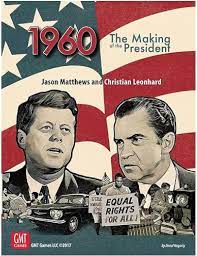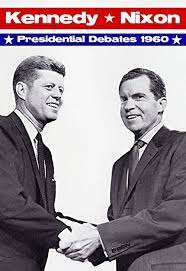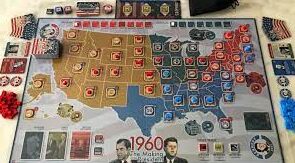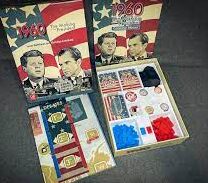Introduction:
Conducting comprehensive analysis on a work require examining its the elements. Its history, location, time period, creator’s background, and the intended audience must be paid attention to. This blog post critically examines the board game “1960: Making of the President,” ( first edition) assessing its historical accuracy, game design effectiveness and its communication with players.

https://www.gmtgames.com/p-984-1960-the-making-of-the-president-3rd-printing.aspx
Background of the Game:
Inspired by GMT’s card-driven game, Twilight Struggle, “1960: Making of the President” published in 2007. Post-release, it quickly gained popularity, earning nominations and winning awards such as the “2008 International Gamers Awards – General Strategy; Two-players.” The game’s success is due to its captivating plot surrounding the 1960 election and featuring iconic figures John F. Kennedy and Richard M. Nixon who are loved by many. The 2017 second edition by GMT Games continued its appeal, incorporating elements of American national values and portraying the country’s election culture.

Rivalry That Shaped History:
Centered on the 1960 U.S. presidential election and the Kennedy-Nixon rivalry, the game accurately incorporates historical events. From Nixon’s lazy shave to President Eisenhower’s late endorsement and the ‘Catholic question,’ these events significantly influenced the election. Players act as candidates and campaign managers, attempting to secure electoral votes. While accurately portraying historical events, the game’s design allows players to reshape history. Despite Kennedy’s historical win, the game emphasizes the intense competition, highlighted by the slim 118,000-vote difference.
Making of the Design:
Designed by Christian Leonhard and Jason Matthews, the game includes various components: The Board, Campaign Manual, State Seals, Issue tiles, Candidate tokens, Momentum markers, Turn Track & Phase Track markers, Cubes, Endorsement markers, Campaign cards, Candidate cards, Prevention Event markers, Endorsement cards, Political Capital bag, and the Debate Board. The electoral map of the USA is used with inserted state boxes. These state boxes vary in two, those with red edges and elephant icons inserted representing Nixon and those with blue edges and donkey representing Kennedy. The choice of colors and symbols are historically accurate as they were used in the real election that took place.


How to Become the President:
With nine turns representing campaign weeks, players aim to accumulate electoral votes to become the president. The historically accurate event cards serve as both educational tools and immersive elements, informing players about the real election.”The Making of the President” board game offers a simulation of the U.S. presidential election process through various key mechanics.
It is a card-driven game where players use Candidate Cards and Event Cards to shape the course of the game, representing candidate strengths, weaknesses, and unpredictable events. Players managing Action Points (AP) ,campaign, fundraise, and respond to events. The game includes Primary Elections, National Conventions, and the Campaign phase, where players compete for electoral votes. Money management is crucial, requiring decisions on fundraising and resource allocation. The game’s success lies in combining historical elements with the opportunity for players to reshape history, offering a unique election simulation.
Conclusion:
“1960: Making of the President” emerges as a captivating and historically informed board game. It allows players to delve into the intricacies of the 1960 U.S. presidential election. The game’s success is rooted in its meticulous design, educational value, and the strategic challenges it presents, making it an engaging choice for both history enthusiasts and board game lovers.